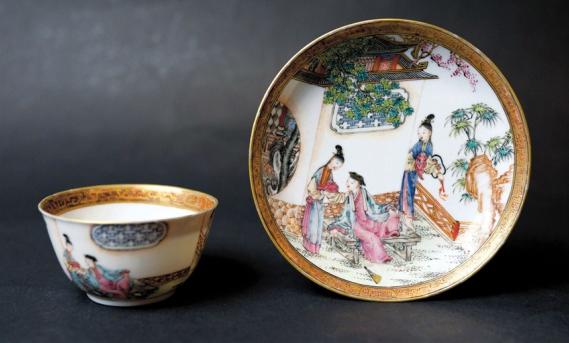

This Qing Dynasty overglaze porcelain, exported to Britain, features a scene from "Romance of the West Chamber."
A naked man and woman are making love lying under a willow tree. Their hair is down and they are bulkier than ordinary Chinese. The scene is from a Chinese blue-and-white porcelain plate, with a cup with the same theme, made and exported in the 16th century.
The porcelain was specially commissioned for foreigners, called chu kou ci, but since the craftsmen had never seen a foreigner before, the figures are animalistic, almost savage.
Much of the outside world.s early knowledge of China was based on such fine porcelains.
China has been exporting ceramics since the Han Dynasty (206 BC-AD 220), but exported porcelain ramped up in the early part of the Qing Dynasty (1644-1911) when Emperor Kangxi (1654-1722) lifted a ban on maritime trading. It was estimated by the Dutch East India Company that about 3 million pieces of chinaware reached Europe every year during his reign.
Before the 17th century, most Europeans were able to make only mugs and other rudimentary items from glazed pottery which proved to be fragile and easily shattered. So when they discovered the much stronger Chinese ceramics, they placed large orders.
.The craft skills of making Chinese porcelain were incomparable, so that no other country could produce porcelain ware of the same quality,. says Low Cheong Sin, a veteran Shanghai-based Malaysian collector of exported Chinese porcelain.
.The other secret of china-making was that you couldn.t find the same material in other countries,. Low explains. China clay can be fired at a very high temperature so that it turns whiter and harder.
Fine exported chinaware was a sign of luxury and was in demand by aristocrats all over the continent. They were called .white gold. because 50 grams of the finest Chinese porcelain could be traded for 50 grams of gold.
Now Chinese have started collecting these exported porcelains, which, when they were produced, were specially commissioned for the foreign market and not available domestically. These exported objects have reached such a high status of luxury in their country of origin that the finest small .famille rose. cups have been sold at auction for as much as 500,000 yuan (US$82,379).
Famille rose is .the desirable French .rose family. group of Chinese porcelain wares characterized by decoration painted in opaque overglaze rose colors,. according to Encyclopedia Britannica.
Virtually every exported cup, plate or vase began its life in Gaolin Mountain, which lies in China.s porcelain capital, Jingdezhen, in Jiangxi Province. The Kaolin clay from the mountain, also called china clay, is infused with another mineral substance, mica, which makes it harder when formed into porcelain.
According to Low, in the past there were two kinds of kilns — imperial and civil. .Imperial kilns only produced china for the emperor with the best craftsmen and the best china clay. Once the chinaware had a tiny flaw, it was destroyed,. he says.
Fine exported porcelain was all made in the civil kilns in Jingdezhen. .But they are of better quality than others afterward since the exported ceramics were made for celebrities and the rich in Europe, and they had higher standards,. he says.
Trading companies sprouted in European countries and demanded a slice of the newly discovered treasure. Porcelain was more than dinnerware or cups, but compelling Chinese works of art that lured the world.
One of the trading ships designed for trade with the Orient, the Götheborg, built by The East India Company, sank off the Swedish coast in 1745 after returning from its third voyage to China. All the goods on what was then the largest operational wooden vessel in the world were from China, including tea, silk and Chinese ceramics. It was said that all the commodities aboard were worth an amount approaching one year.s GDP in Sweden at the time.
Only 8 percent of the goods were salvaged, mainly Chinese ceramics, but with that the investors recovered their costs and actually made a small profit.
Another factor driving the market for exported porcelain is that, while expensive, good values still can be found.
.I like the exported ceramics in European countries because there you will find more variety, usually at auction houses in the United Kingdom and in the Netherlands,. Low says. .In China, people give too much attention to porcelain from imperial kilns, but the price is outrageous, at least 500,000 yuan. But I think there still a lot potential for exported ceramics..
The differences in the exported porcelains also attract buyers. Chinese people did not use porcelain vessels with handles like Westerners, sticking to the traditional cups with no handles. As a result, exported, Western-style chinaware of that period is extremely rare in China.
.Except for shapes and style, normally exported ceramics have more intricate patterns and figures that depict the daily life in China. Also, only in Chinese exported porcelain can you see golden designs around the edge of chinaware. In China you won.t find any gold elements on ceramic pieces,. Low says.
Some of the exports are completely covered with a golden glaze, which required special skills. Except for china with overglazed colors — those enameled twice — Low says he prefers blue-and-white porcelain. .It is more simple and elegant,. he says.
Low has collected about 200 exported porcelains, among which he adores those depicting figures and stories. A court lady in a high-collared qipao dress on a terrace or romantic love stories are very popular motifs.
.When you hold a small cup in your hand and slowly turn it around, it.s like reading a story. The picture is so detailed that you can see the folds in the clothes,. Low says.
Copyright ©1999-2018
Chinanews.com. All rights reserved.
Reproduction in whole or in part without permission is prohibited.